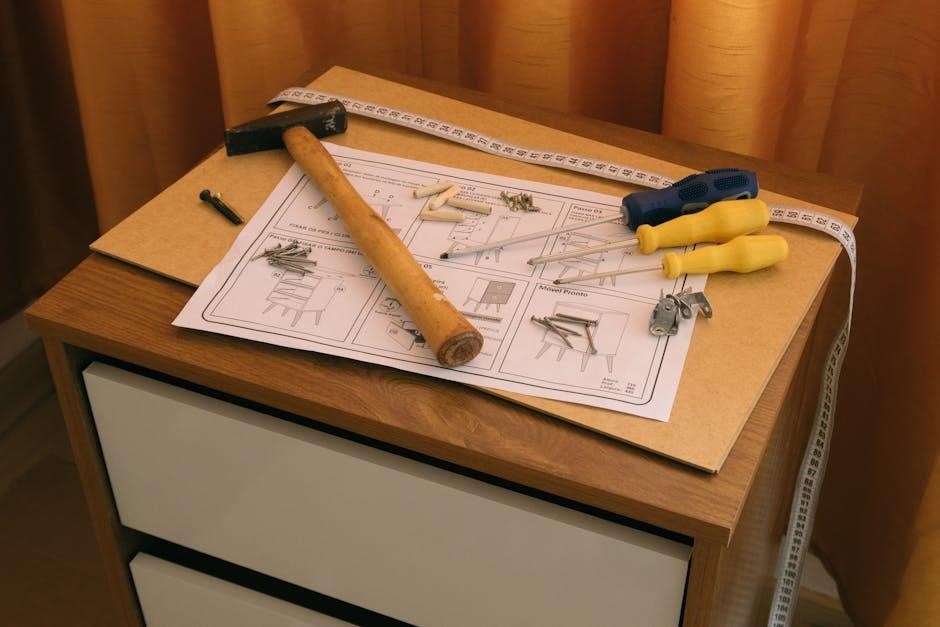tent instructions manual
Safety Instructions
Always read the manual before setup․ Choose a flat, dry campsite away from trees․ Never use open flames inside the tent․ Ensure proper ventilation to prevent condensation․ Avoid pooling water on the tent fabric․ Store the tent dry to prevent mold and damage․
Pre-Assembly Checks
Before setting up your tent, ensure all components are unpacked and accounted for․ Check the tent fabric, poles, stakes, and rain fly for any signs of damage or wear․ Lay out the tent on a clean, dry surface to inspect for holes or tears․ Verify that all poles are intact and free of bends or breaks․ Inspect stakes and guy lines for rust or fraying․ Ensure the tent footprint and rain fly are properly aligned with the tent body․ Familiarize yourself with the assembly manual to confirm the correct sequence of steps․ Double-check that all necessary tools, such as a mallet or screwdriver, are available․ If any parts are missing or damaged, contact the manufacturer before proceeding․ Clear the campsite of debris and level the ground to ensure a stable setup․ Always follow the manufacturer’s guidelines for pre-assembly preparation to guarantee a safe and successful installation․
Setting Up the Tent
Begin by laying out the tent footprint on a level, dry surface; Attach the tent body to the footprint using the provided clips or hooks․ Unfold the tent and locate the pole sleeves․ Insert the main poles through the sleeves, ensuring they fit securely into the grommets at the corners․ Stand the tent upright and connect the ridgepole to form the roof structure․ Use the stakes to secure the tent corners to the ground, starting with the windward side for stability․ Tighten the guy lines to pull the tent taut and ensure even tension across the fabric․ Attach the rain fly, aligning it with the tent’s roof peaks, and secure it with clips or hooks․ Finally, stake down the rain fly’s edges and tighten all connections to complete the setup․ Always follow the sequence outlined in the manual to ensure proper structural integrity and weather resistance․
Disassembly and Storage
Begin by removing the rain fly and detaching it from the tent body․ Carefully extract the poles from the sleeves and collapse them into sections, storing each section separately․ Release the guy lines and stakes, ensuring all are accounted for to avoid loss․ Fold the tent body neatly, starting from the sides and rolling it towards the bottom to minimize wrinkles․ Place the tent, poles, stakes, and rain fly into their respective storage bags․ Store the tent in a cool, dry place to prevent moisture damage and mold․ Avoid leaving the tent folded for extended periods to maintain its shape and water-repellent coating․ Regularly inspect stored items for signs of wear or damage․ Always ensure the tent is completely dry before storage to preserve its condition and longevity․ Proper storage will ensure the tent remains in good condition for future use․

Tent Components
A standard tent includes the main fabric, poles, stakes, guy lines, and a rain fly․ Each component is essential for structural integrity and weather protection․
Tent Fabric
Tent fabric is crafted from durable, water-resistant materials like nylon or polyester․ It features a waterproof coating to repel rain and UV protection to prevent fading․ The fabric is designed to withstand wind and weather conditions while maintaining breathability․ Look for double-stitched seams and reinforced stress points for added durability․ Some tents include fire-retardant treatments for safety․ Always inspect the fabric for tears or damage before use․ Regular cleaning and proper storage can extend the fabric’s lifespan․ Avoid harsh chemicals to prevent damage to the waterproof layer․ Ensure the tent is completely dry before storage to prevent mold or mildew․ Proper care of the fabric ensures optimal performance and longevity of your tent․ Follow manufacturer guidelines for cleaning and maintenance to preserve the fabric’s integrity and water-repellent properties․
Poles
Tent poles are typically made of lightweight yet durable materials like aluminum or fiberglass․ They come in sections that easily connect to form the tent’s frame․ Poles should be assembled by inserting the ends into designated grommets on the tent fabric․ Ensure all connections are secure to maintain structural integrity․ Handle poles with care to avoid bending or breaking․ When disassembling, remove poles gently to prevent damage․ Regularly inspect poles for signs of wear or corrosion, especially after exposure to harsh weather․ Store poles in a dry place to prevent rust․ If a pole is damaged, contact the manufacturer for replacement parts․ Proper handling and maintenance of poles are essential for the tent’s stability and longevity․ Always follow the manufacturer’s instructions for assembling and caring for the poles to ensure safe and effective use․ Replace any damaged sections promptly to avoid compromising the tent’s structure during use․
Stakes and Guy Lines
Stakes and guy lines are essential for securing your tent and ensuring stability․ Stakes should be driven into the ground at a 45-degree angle, starting with the corners and working inward․ Use high-quality stakes made of durable materials like aluminum or steel for better grip․ Guy lines should be tightly attached to the tent’s loops and anchored to the ground using stakes․ Ensure the lines are taut but not overly tightened, as this could damage the tent fabric․ For added stability, distribute the tension evenly across all guy lines․ Avoid staking in soft or wet ground, as this can cause the tent to shift․ Regularly inspect stakes and guy lines for wear or rust, replacing them as needed․ Proper use of stakes and guy lines ensures the tent remains secure, even in windy conditions, and extends its lifespan․ Always follow the manufacturer’s recommendations for stake placement and guy line tension;
Rain Fly
The rain fly is a critical component for waterproofing your tent․ It should be installed securely over the top of the tent, ensuring all sides are properly aligned and attached․ Use the provided clips or hooks to fasten the rain fly to the tent poles, making sure it is tightly fitted․ Adjust the fly so it hangs evenly, avoiding sagging areas where water could collect․ Stake the fly’s edges to the ground using guy lines and additional stakes for maximum stability․ Ensure the rain fly does not touch the main tent fabric to prevent moisture transfer․ Regularly inspect the rain fly for tears or damage, and apply waterproofing treatments as needed․ Proper installation of the rain fly ensures your tent remains dry and protected during rainstorms, enhancing your camping experience․ Always follow the manufacturer’s guidelines for rain fly setup and maintenance․ Keep the rain fly clean and dry during storage to prevent mildew buildup․

Assembly Instructions
Begin by laying out the tent footprint and attaching poles․ Secure poles to corners using clips․ Tighten all connections firmly and ensure the tent stands upright․ Stake edges for stability․
Laying Out the Tent
Start by selecting a level, dry campsite free from debris and obstructions․ Unfold the tent and lay it flat on the ground, ensuring the footprint aligns with the tent’s base․ Position the tent door facing away from prevailing winds for better stability․ Identify the four corners and locate the stake loops․ Use stakes to secure each corner tightly, beginning with the front and rear corners․ Make sure the tent fabric is evenly spread and not bunched up․ Once the corners are staked, move to the sides, ensuring the tent remains taut․ Properly laying out the tent ensures a smooth assembly process and prevents wrinkles or damage to the fabric․ Always follow the manufacturer’s guidelines for optimal setup․
Attaching Poles
To attach the poles, begin by identifying the color-coded sleeves on the tent corresponding to each pole․ Insert the pole tips into the grommets at the tent’s corners, ensuring they are fully seated․ Gently push the poles through the sleeves, aligning them with the tent’s structure․ Once the poles are in place, stand the tent upright and ensure the poles are fully extended and securely connected․ For dual-hub poles, snap them into place by applying gentle pressure until they click․ Ensure all connections are tight and the tent frame is stable․ If using a two-pole system, attach the second pole to the opposite side, repeating the process․ Double-check that all poles are properly seated and the tent stands upright without sagging․ This step is crucial for maintaining the tent’s structural integrity and ensuring a secure setup․
Securing the Tent
After attaching the poles, secure the tent by staking it down․ Start with the four corner stakes, ensuring they are driven into the ground at a 45-degree angle to maximize stability․ Tighten the tent fabric by adjusting the stake positions until the walls are taut and the roof is firm․ Use guy lines to further secure the tent, attaching them to the loops on the tent’s edges and staking them into the ground․ Ensure all lines are evenly tightened to prevent sagging․ For added stability, stake down the door flaps and any extra tie-outs․ Finally, walk around the tent to check for loose areas or fabric that may be too tight, making adjustments as needed․ Properly securing the tent ensures it can withstand wind and weather conditions effectively․

Troubleshooting Common Issues
Inspect for leaks, tighten loose stakes, and check for pole damage․ Ensure proper waterproofing and fabric tension to address sagging or water ingress issues promptly․
Leaks and Waterproofing
To address leaks, inspect the tent for any punctures or seam gaps․ Apply a waterproofing spray or sealant to affected areas․ Ensure the rain fly is securely attached and properly angled to direct water away․ Regularly cleaning the tent fabric can prevent mold and maintain its water-repellent properties․ If leaks persist, check the integrity of guy lines and stakes, as loose connections may allow water ingress․ Always store the tent in a dry, well-ventilated area after use to prevent moisture buildup․ For severe leaks, consider applying a patch kit specifically designed for tent fabric․ Proper maintenance ensures the tent remains waterproof and extends its lifespan․
Pole Damage
Pole damage can occur due to improper handling or extreme weather conditions․ Inspect poles regularly for dents, bends, or breaks․ Avoid forcing poles into sockets, as this may cause damage․ If a pole is bent, carefully straighten it using a gentle, even pressure․ For broken poles, use the included repair sleeve or splint to reinforce the area temporarily․ Store poles in their carrying case when not in use to prevent accidental damage․ Always follow the manufacturer’s instructions for assembly and disassembly․ Replace damaged poles promptly to ensure the tent’s structural integrity․ By handling poles with care and addressing issues promptly, you can extend the lifespan of your tent and ensure safe use during camping trips․

Maintenance and Care
Regularly clean the tent with mild soap and water․ Avoid machine washing․ Dry thoroughly before storage to prevent mold․ Store in a cool, dry place to maintain quality․
Cleaning the Tent
Regular cleaning is essential to maintain your tent’s durability and water resistance․ Start by brushing off loose dirt and debris with a soft-bristle brush․ For more thorough cleaning, mix a mild soap solution with warm water․ Use a sponge or cloth to gently scrub the tent fabric, avoiding harsh chemicals or abrasive cleaners that can damage the waterproof coating․ Focus on high-wear areas like doors, windows, and stakes․ For stubborn stains, apply a small amount of soap directly and rinse thoroughly with clean water․ Avoid machine washing, as it can damage the tent’s seams or poles․ Allow the tent to air dry completely in direct sunlight to prevent mold and mildew․ Never store the tent while it is damp, as this can lead to permanent damage․ Regular cleaning ensures your tent remains in prime condition for future use․

Storing the Tent
Proper storage is crucial to maintain your tent’s condition․ Before storing, ensure the tent is completely clean and dry to prevent mold and mildew․ Store it in a cool, dry place, away from direct sunlight and moisture․ Avoid basements or attics prone to humidity․ Once cleaned and dried, fold the tent neatly and place it in its original storage bag or a breathable fabric bag․ Store poles and stakes separately in labeled bags to avoid damage․ Do not compress the tent tightly, as this could cause creases or damage the waterproof coating․ Check for any signs of wear or damage before storage and repair them promptly․ Keep all components, such as guy lines and rain flies, organized and included in the storage bag․ Regular inspection ensures your tent remains in good condition for future use․
Additional Tips for Setup
Use a tarp under the tent for extra moisture protection; Choose a level, dry site and clear debris before pitching․ Secure stakes firmly and tighten guy lines evenly for stability․
Choosing a Campsite
Selecting the right campsite is crucial for a safe and enjoyable experience․ Look for a flat, dry area free from rocks, branches, and other hazards․ Ensure good drainage to avoid water pooling․ Check local regulations and obtain necessary permits․ Opt for a spot near a water source but avoid low-lying areas prone to flooding․ Choose a location with natural wind protection, such as trees or hills, to reduce exposure․ Avoid areas with standing trees or power lines overhead․ Clear the site of leaves and debris before setting up․ Make sure the area is large enough to accommodate your tent and allow space for easy setup and movement․ Always respect the environment and leave the site as you found it․

Using a Tarp
A tarp is essential for protecting your tent from moisture and wear․ Lay the tarp flat on the ground before setting up your tent, ensuring it extends beyond the tent’s base․ Secure the edges with rocks or additional stakes to prevent wind from lifting it․ Avoid overlapping the tarp with the tent’s walls to minimize water seepage․ For extra protection, place a second tarp above the tent as a rain fly, attaching it to trees or poles with guy lines․ Ensure all edges are tightly secured to prevent flapping in the wind․ Regularly inspect the tarp for holes or damage and repair promptly․ Using a tarp adds an extra layer of waterproofing and extends the lifespan of your tent by shielding it from direct ground contact and weather conditions․